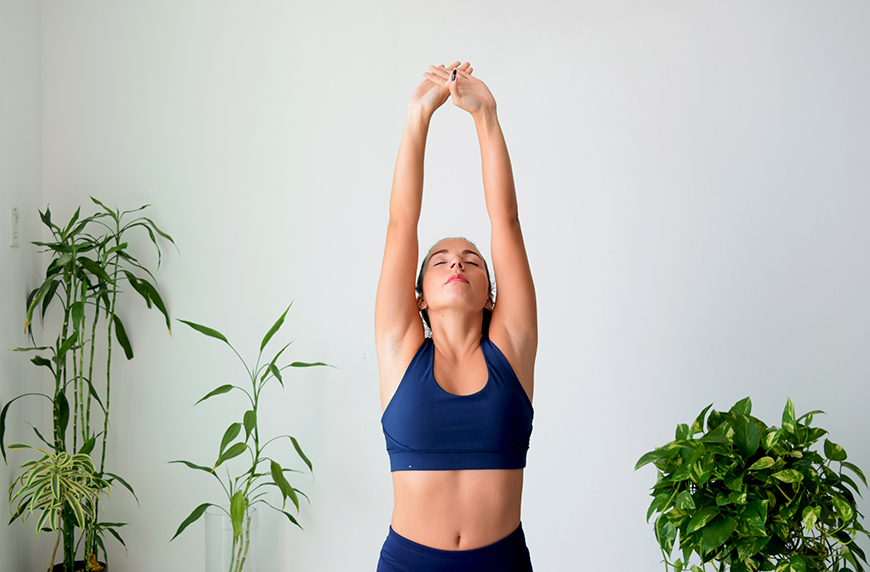
January 22, 2020 at 06:00PM by CWC
Stand in front of a mirror for a sec. If you’re unintentionally sticking out your belly and butt and your hips are forward, you could have a swayback posture and not even know it. According to Danielle Weis, DPT, a physical therapist and orthopedic clinical specialist at Spring Forward Physical Therapy, it’s a type of back posture where your pelvis is shifted forward and rotated slightly backward with excessive rounding in the mid-back and upper part of the lumbar spine.
Whether swayback posture is your body’s natural anatomical alignment or a result of poor posture, it can be the reason why you’re experiencing aches and pain on the regular. “Swayback can be painful because this posture positions the spine and pelvis in a suboptimal alignment. It throws off the body’s center of gravity, which makes it more difficult for the spinal and gluteal muscles to activate, support, and function,” says Dr. Weis. “This position also creates tightness and restriction in muscles, including the hamstrings, chest, and anterior neck muscles. Over time, it can also causes stiffness to form between the vertebral segments throughout the spine, which can cause neck, upper, mid, and lower back pain, as well as hip and knee pain.”
The good news is swayback posture can be improved—and even corrected! “Think about setting your shoulders down and back, keeping your ears over your shoulders, and bringing those forward-set hips backward. Aim to activate the core to provide back support,” says Dr. Weis. You can also add in core-strengthening exercises (like plank and heel taps), postural strengthening, and glutes strengthening. Then, do these physical therapist-approved stretches on the regular.
The best stretches to soothe swayback posture
1. Pec stretch
ADVERTISEMENT
ADVERTISEMENTKate Spade Autumn/Winter Sale |
This stretch will open up the front of the chest, counteracting the forward head and rounded shoulders and spine position.
How to do a pec stretch:
- Stand in a doorway with one forearm supported against the frame, creating a 90-degree bend at the elbow and between the arm and trunk.
- Lean forward into the doorway and rotate the body away from the frame to create a stretch in the pecs and chest. I prefer to do one side at a time, but this can also be achieved by bringing both shoulders and elbows to 90 degrees (think about a goal post position), resting the forearms against the doorframe, and leaning the body weight forward to feel a stretch in both sides of the chest.
- Hold for 30 to 60 seconds at a moderate level for a pain-free stretch.
2. Hamstring stretch
When the pelvis sits too far forward and the hips are too extended, this can cause tightness in the hamstrings. Stretching can counteract the tightness to improve flexibility, as well as improve your posteriorly-rotated pelvis and overextended hips.
How to do a hamstring stretch:
- To stretch, first sit on a chair or on the floor and extend one leg out in front of you (toes pointed up), keeping the other leg bent.
- Keep your back straight (no rounding) and hinge forward at the hips as you reach for your toes. Don’t allow the back to round, as this reduces the stretch and feeds into poor posture.
- Hold for 30 to 60 seconds at a moderate level for a pain-free stretch.
3. Thoracic extension stretch
The goal here is to counteract the forward-flexed upper back by creating an extension force to stretch the upper back segments.
How to do a thoracic extension stretch:
- Grab a foam roller and place it across the bottom of your shoulder blades.
- Bring your hands behind your head and support your head as you breathe in. As you exhale, slowly drop the head back and extend your back over the foam roller, using the weight of the upper body over the roll to create a stretch in the spine.
- Slowly repeat 2 to 3 times at that level, then roll your body down so the foam roller is then placed about half an inch up from where you just were.
- Repeat this extension process as you slowly breathe and extend over the roll. Do this until you reach the shoulders. This should feel good—not painful. If you hit an area where it feels painful, skip that segment.
These are the best stretches to do before bedtime:
The “Triple S” is the fastest way to correct your posture. Then try the four posture-bettering shoulder exercises that are no match for a desk job.
Author Tehrene Firman | Well and Good
Selected by CWC

ADVERTISEMENT
ADVERTISEMENTUp to 30% off Gift Sets |







